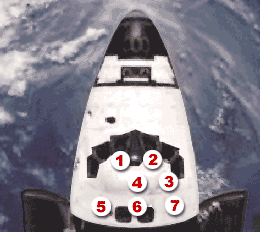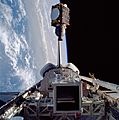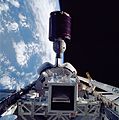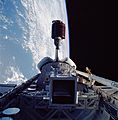STS-51-G facts for kids
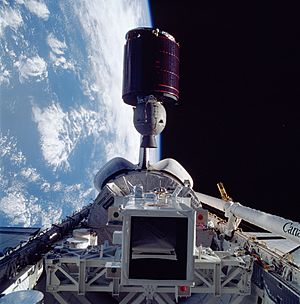
Discovery deploys Morelos-1.
|
|
| Names | Space Transportation System-18 |
|---|---|
| Mission type | Satellites deployment |
| Operator | NASA |
| Mission duration | 7 days, 1 hour, 38 minutes, 52 seconds (achieved) |
| Distance travelled | 4,693,051 km (2,916,127 mi) |
| Orbits completed | 112 |
| Spacecraft properties | |
| Spacecraft | Space Shuttle Discovery |
| Launch mass | 116,357 kg (256,523 lb) |
| Landing mass | 92,610 kg (204,170 lb) |
| Payload mass | 17,280 kg (38,100 lb) |
| Crew | |
| Crew size | 7 |
| Members |
|
| Start of mission | |
| Launch date | June 17, 1985, 11:33:00 UTC |
| Rocket | Space Shuttle Discovery |
| Launch site | Kennedy Space Center, LC-39A |
| Contractor | Rockwell International |
| End of mission | |
| Landing date | June 24, 1985, 13:11:52 UTC |
| Landing site | Edwards Air Force Base, Runway 23 |
| Orbital parameters | |
| Reference system | Geocentric orbit |
| Regime | Low Earth orbit |
| Perigee | 353 km (219 mi) |
| Apogee | 359 km (223 mi) |
| Inclination | 28.45° |
| Period | 91.70 minutes |
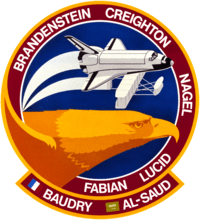 STS-51-G mission patch 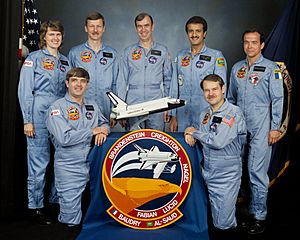 Back: Shannon W. Lucid, Steven R. Nagel, John M. Fabian, Sultan bin Salman Al Saud, Patrick Baudry, Front: Daniel C. Brandenstein, John O. Creighton |
|
STS-51-G was an important space mission by NASA's Space Shuttle program. It was the 18th flight of a Space Shuttle and the fifth flight for the Space Shuttle Discovery. This seven-day mission started from Kennedy Space Center, Florida, on June 17, 1985. It landed at Edwards Air Force Base, California, on June 24, 1985.
A special part of this mission was having Sultan bin Salman Al Saud from Saudi Arabia on board. He became the first Arab, the first Muslim, and the first member of a royal family to fly into space! This mission was also the first Space Shuttle flight where all the astronauts were new to the Shuttle program.
Contents
Meet the Crew
The STS-51-G mission had a crew of seven astronauts. They worked together to complete all the tasks in space.
- Daniel C. Brandenstein was the Commander. This was his second trip to space.
- John O. Creighton was the Pilot. This was his first time in space.
- John M. Fabian was a Mission Specialist. This was his second and last space flight.
- Steven R. Nagel was a Mission Specialist. This was his first space flight.
- Shannon W. Lucid was a Mission Specialist. This was her first space flight.
- Patrick Baudry was a Payload Specialist from France. This was his only space flight. He worked for the French space agency, CNES.
- Prince Sultan bin Salman Al Saud was a Payload Specialist from Saudi Arabia. This was his only space flight. He was part of the RSAF.
Prince Sultan was the first person from a royal family to fly in space. He was also the first Arab and the first Muslim astronaut.
Crew Seating
The astronauts had specific seats for launch and landing.
| Seat | Launch | Landing | |
|---|---|---|---|
| S1 | Brandenstein | Brandenstein | |
| S2 | Creighton | Creighton | |
| S3 | Lucid | Fabian | |
| S4 | Nagel | Nagel | |
| S5 | Fabian | Lucid | |
| S6 | Baudry | Baudry | |
| S7 | Al Saud | Al Saud |
What the Mission Did
The Discovery Space Shuttle launched from Launch Complex 39A on June 17, 1985. The mission had several important goals.
Deploying Satellites
The main job of STS-51-G was to launch three communications satellites into space. These satellites help people talk to each other across the world.
- Arabsat-1B for the Arab Satellite Communications Organization.
- Morelos-1 for Mexico.
- Telstar-303 for AT&T Corporation.
All three satellites were successfully launched from Discovery. They used special booster rockets called Payload Assist Modules (PAM-D) to reach their correct orbits.
SPARTAN-1 Experiment
The mission also carried SPARTAN-1. This was a special tool for astronomy, which is the study of stars and space. SPARTAN-1 could be released from the Space Shuttle and fly on its own. It had 140 kg (310 lb) of equipment for studying space. After flying freely and collecting data, it was successfully brought back to the Space Shuttle.
Other Experiments
Discovery also carried other experiments:
- An experimental furnace for processing materials in space.
- Two French experiments to study how the human body reacts to space (French Echocardiograph Experiment (FEE) and French Postural Experiment (FPE)).
- Six "Getaway Special" (GAS) experiments. These are small, self-contained experiments that can be carried on the Space Shuttle. Most of them worked well.
The mission also tested a new autopilot system for the Space Shuttle. This system made the Shuttle even better at flying itself.
High Precision Tracking Experiment (HPTE)
Another important experiment was the High Precision Tracking Experiment (HPTE). This experiment was part of the Strategic Defense Initiative (SDI), sometimes called "Star Wars." The HPTE was designed to track objects with high accuracy. It had a small problem deploying at first, but it was successfully deployed later in the mission.
Mission End
The Discovery landed safely at Edwards Air Force Base on June 24, 1985. The mission lasted for 7 days, 1 hour, 38 minutes, and 52 seconds.
Mission Patch
The STS-51-G mission patch shows how much aviation technology has grown in the United States. It features the Discovery Space Shuttle flying above the Wright Flyer, which was one of the first airplanes. A golden eagle forms the bottom part of the patch. The names of the crew members are around the edge of the patch. The French and Saudi crew members have their country's flag next to their names.
Wake-up Calls
Since the Project Gemini program, NASA has had a tradition of playing music to wake up astronauts in space. This started with Apollo 15. The songs are often chosen by the astronauts' families and usually have a special meaning to one of the crew members or relate to their daily tasks.
| Flight Day | Song | Artist/Composer |
|---|---|---|
| Day 2 | "I Feel the Earth Move" | Carole King |
| Day 3 | "Proud Mary" | Creedence Clearwater Revival |
| Day 4 | "Sailing" | Christopher Cross |
| Day 5 | "Jonathan Livingston Seagull" | Neil Diamond |
| Day 6 | "Wedding March" | Felix Mendelssohn |
Images for kids
See also
 In Spanish: STS-51-G para niños
In Spanish: STS-51-G para niños


